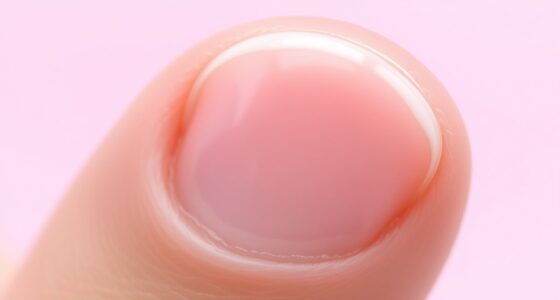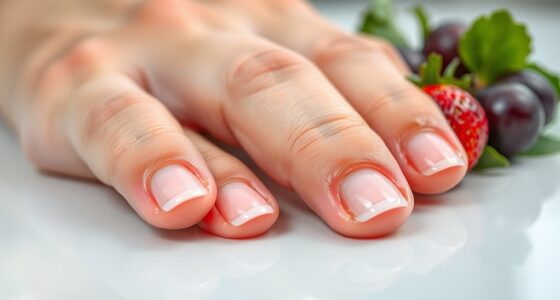Fingernails and toenails differ in thickness and growth due to their distinct structures and functions. Your fingernails are thinner, more flexible, and grow faster because their nail matrix is more active and receives better blood flow. Toenails are thicker, denser, and grow more slowly, supporting weight and protection during walking. External factors like environment, activity levels, and health also influence these differences. To discover more about these variations, keep exploring the details behind nail biology and care.
Key Takeaways
- Fingernails have a more active nail matrix, producing keratin rapidly for flexibility, while toenails have a larger, denser matrix for strength.
- Toenails are thicker and more robust due to compact keratin, designed to protect toes during walking and standing.
- Fingernails receive better blood circulation, delivering more nutrients, which promotes faster growth compared to toenails.
- Environmental exposure and external factors like humidity, sunlight, and chemical use influence toenail thickness and growth rate.
- Age, hormones, and blood circulation variations affect nail growth, causing differences in thickness and growth speed between fingers and toes.
Structural Differences Between Fingernails and Toenails
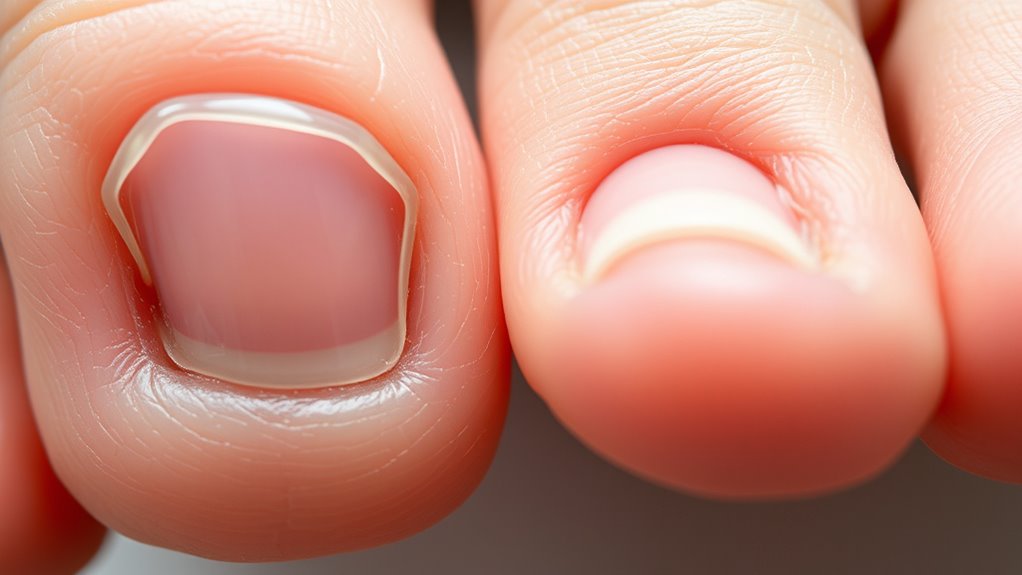
Although fingernails and toenails share similar basic structures, they differ markedly in their composition and form. The nail matrix, located under the cuticle, is where your nail begins to grow. In fingernails, the matrix is more active, producing keratin more rapidly, which results in thinner, more flexible nails. Toenails, on the other hand, have a larger and more robust nail matrix, producing a denser keratin structure. This denser keratin makes toenails thicker and stronger to withstand pressure and friction. The keratin structure in toenails is more compact, contributing to their rigidity. These differences are adaptations to their respective environments, with fingernails designed for delicate tasks and toenails built for protection and support during walking and standing. Automation in industries also influences nail growth patterns, though biological factors remain the primary determinants.
The Role of Environmental Factors in Nail Growth

Environmental factors like humidity can affect how quickly your nails grow, making them stronger or more brittle. Sunlight helps your body produce vitamin D, which is essential for healthy nail development. Exposure to chemicals, such as cleaning products or harsh polishes, can hinder growth and damage your nails over time. Proper hydration and the use of self watering plant pots can also support overall nail health by maintaining optimal moisture levels.
Humidity’s Impact on Growth
Humidity levels can substantially influence how quickly and healthily your nails grow. Higher humidity effects increase moisture levels in your nails and surrounding skin, promoting faster growth. Conversely, low humidity can lead to dryness, brittleness, and slower nail development. To optimize nail growth, consider these factors:
- Maintain moderate humidity indoors to prevent excessive dryness or over-moisturization.
- Use moisturizers to support proper moisture levels, especially in dry environments.
- Avoid prolonged exposure to excessively humid conditions, which can weaken nails and cause fungal issues.
- Proper environmental conditions are essential to support healthy nail growth and prevent issues related to moisture imbalance.
Sunlight and Vitamin D
Sunlight plays a vital role in promoting healthy nail growth by enabling your body to produce vitamin D, a nutrient essential for cell development. When you get sunlight exposure, your skin synthesizes vitamin D, which supports the growth of nail tissues and influences nail pigmentation. Adequate vitamin D levels can lead to stronger, healthier nails and may prevent issues like brittleness or discoloration. Your nails reflect your overall health, and environmental factors such as sunlight directly impact their appearance and growth rate. Limited sunlight exposure can slow down nail growth and cause changes in nail pigmentation. To optimize nail health, spend time outdoors regularly, ensuring your skin receives enough sunlight, which helps maintain the delicate balance necessary for vibrant, resilient nails. Incorporating botanical art and natural decor into your surroundings can also promote a calming environment that supports overall wellness and healthy nail development.
Exposure to Chemicals
Exposure to harsh chemicals can profoundly hinder nail growth and damage the nails’ overall health. Chemical exposure from products like nail polish, cleaning agents, and solvents can weaken the nail structure and slow down growth. When you frequently use nail polish, especially with harsh ingredients, your nails become more susceptible to damage and breakage. To protect your nails, consider these tips:
- Limit chemical exposure by choosing acetone-free nail polish removers.
- Wear gloves when handling cleaning chemicals or other harsh substances.
- Give your nails regular breaks from nail polish to allow recovery and reduce chemical buildup.
- Understanding the effects of environmental factors on nail health can help you make better choices to maintain strong, healthy nails.
How Daily Activities Affect Nail Thickness
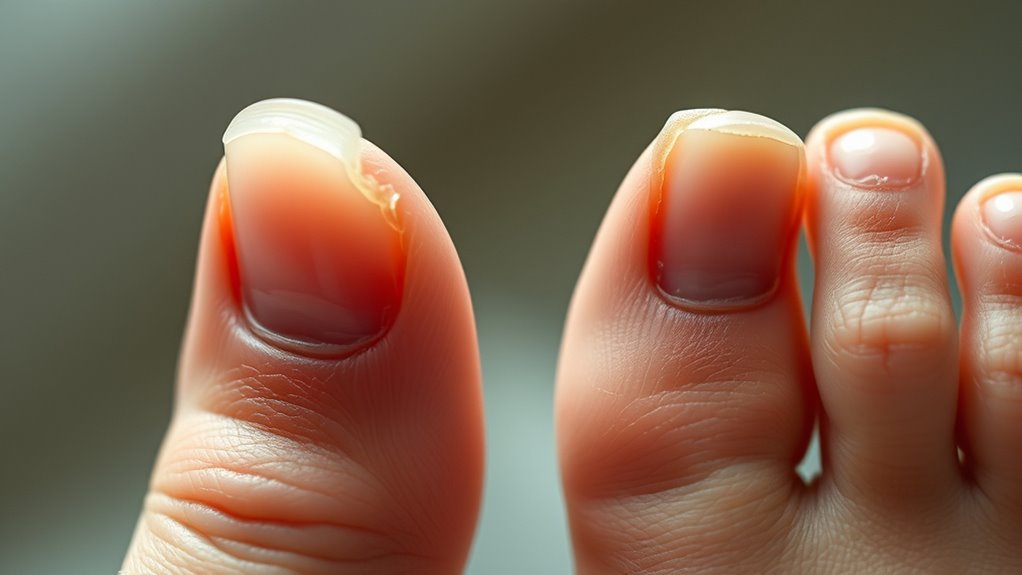
Your daily activities can considerably influence nail thickness; for example, manual labor can cause thickening or damage. How you care for your nails, such as regular trimming or moisturizing, also plays a role. Additionally, the footwear you choose impacts toenail health, especially if you wear tight or ill-fitting shoes regularly. Moreover, infections or underlying health conditions like skin changes or other symptoms of health issues can also affect nail appearance and growth.
Manual Labor Impact
Manual labor can substantially influence nail thickness, especially when you perform repetitive or strenuous tasks. Constantly using your hands, like lifting or digging, can cause nails to thicken as a protective response. Activities such as frequent nail polishing or nail art might weaken the nail surface, prompting your nails to adapt by becoming thicker over time.
Consider these impacts:
- Repetitive gripping or manual tasks can lead to thicker fingernails, especially on the dominant hand.
- Frequent exposure to chemicals from nail polish remover or nail art products may cause thinning, but overcompensation can thicken nails.
- Strenuous work can cause minor trauma, leading to increased keratin production and thicker nails as a repair mechanism.
- Understanding how individual responses to manual labor vary can help you better care for your nails and prevent unnecessary damage.
Your daily activities directly shape nail health and thickness.
Nail Care Habits
Daily habits play a significant role in shaping nail thickness, often through routine activities that either strengthen or weaken the nails. Proper nail care starts with maintaining good cuticle health, as healthy cuticles protect the nail matrix and support growth. Avoid cutting or damaging your cuticles, and instead, gently push them back and keep them moisturized. Nail hydration is equally important; dry nails become brittle and prone to breakage. Regularly applying moisturizing oils or creams helps maintain flexibility and strength. Additionally, protecting your nails from harsh chemicals and excessive water exposure prevents thinning and damage. Consistent nail care habits, such as gentle filing and avoiding biting, can foster thicker, healthier nails over time. Your daily routine directly influences nail resilience and overall health. According to for sale 100, proper nail care products and techniques can further enhance nail thickness and growth.
Footwear Choices
Choosing the right footwear can substantially influence the thickness and health of your toenails. Ill-fitting shoes or high heels can cause pressure, leading to thicker toenails or fungal issues. Daily activities also impact nail thickness, especially if you wear gel nails or nail polish regularly, which can trap moisture and weaken the nail structure. Proper footwear and activity management are essential for maintaining healthy nails and preventing unnecessary thickening. Filtration systems help keep the surrounding environment clean, reducing the risk of infections that can affect nail health.
Blood Circulation and Its Impact on Nail Development
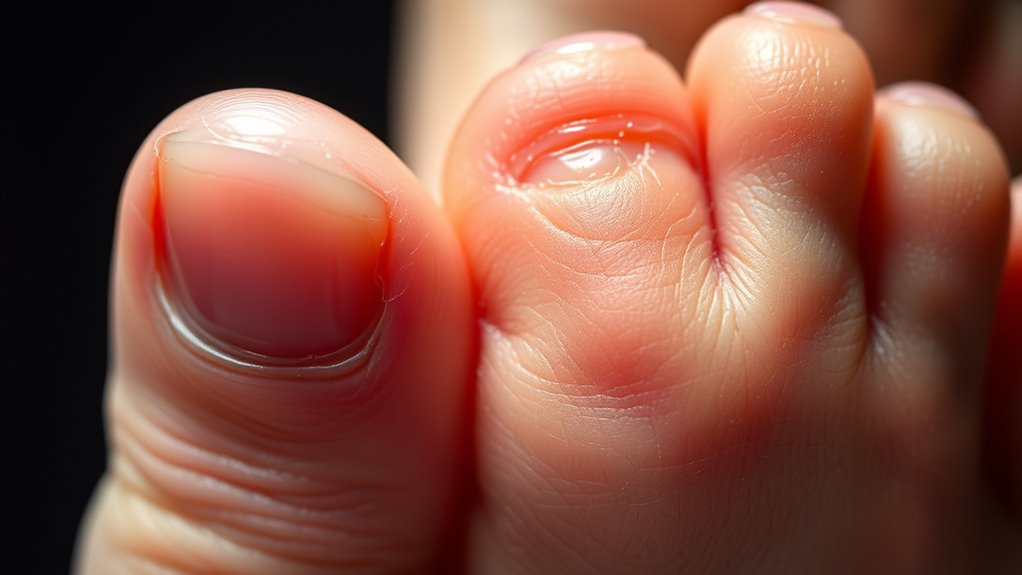
Blood circulation plays a crucial role in the health and growth of both fingernails and toenails. When blood flow is strong, it delivers essential nail nutrients directly to your nail beds, promoting healthy growth. Poor circulation, on the other hand, can slow down nail development and cause brittleness or discoloration. Since your fingernails are more exposed and experience more movement, they typically receive better blood flow than toenails. This difference helps explain why fingernails tend to grow faster and are often healthier than toenails. Improving circulation through regular exercise and avoiding constrictive footwear can enhance nail nutrient delivery, supporting stronger, more resilient nails overall. Good blood flow is essential for maintaining nail health and encouraging optimal growth.
The Influence of Age and Hormonal Changes
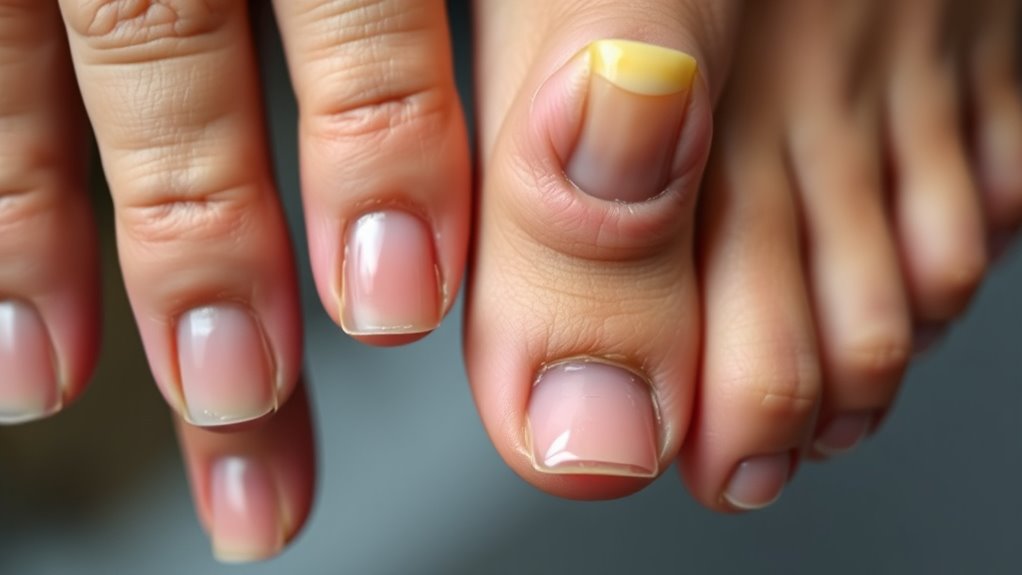
As you age, natural changes in your body considerably influence nail health and growth patterns. Hormonal fluctuations and aging effects cause nails to become thinner, grow more slowly, and sometimes become brittle. You might notice your fingernails grow at a different rate than toenails, partly due to these hormonal shifts. To better understand this, consider:
- Decreased hormone production affects cell turnover, slowing nail growth.
- Aging effects reduce the keratin quality, leading to thinner nails.
- Hormonal fluctuations during life stages can cause irregular nail growth or brittleness.
These changes aren’t just cosmetic—they reflect your body’s evolving physiology. Staying aware of hormonal influences helps you manage nail health better and recognize when changes might require professional attention.
Common Nail Disorders and Their Effects on Growth

Several common nail disorders can substantially impact your nail growth and overall health. Nail fungal infections, or onychomycosis, can cause thickening, discoloration, and brittleness, leading to slower growth or deformities. Ingrown nails occur when the nail edges grow into surrounding skin, causing pain, inflammation, and sometimes infection, which can hinder normal nail growth. Both conditions may result in weakened nails that grow unevenly or stop growing altogether if left untreated. Other disorders, like psoriasis or trauma, can also disrupt nail growth patterns, causing ridges or crumbling nails. Recognizing these issues early helps prevent further damage and promotes healthier nail growth. Proper treatment and care are essential to restore nail strength and prevent long-term complications.
Tips for Maintaining Healthy Nails in Daily Life

Maintaining healthy nails requires consistent daily habits that support their strength and appearance. To keep your nails in top shape, start by choosing nourishing hand moisturizers to prevent dryness and brittleness. Limit the use of harsh nail polish removers, and give your nails regular breaks from polish to breathe and recover. Additionally, avoid biting or picking at your nails, which can cause damage and infections.
Here are three simple tips:
- Apply hand moisturizers regularly to hydrate cuticles and nails.
- Use gentle, acetone-free nail polish removers and take breaks from polish.
- Keep nails trimmed and filed to prevent breakage and snagging.
These habits help maintain healthy, strong nails every day.
Frequently Asked Questions
How Do Nail Thickness Differences Affect Nail Health and Susceptibility to Damage?
Thicker nails generally offer more nail strength, reducing your risk of injury, while thinner nails can be more fragile and prone to damage. If your nails are too thin, they may crack or break easily, making injury prevention harder. Conversely, thicker nails resist damage better but can sometimes cause discomfort. To maintain healthy nails, keep them moisturized and avoid harsh chemicals, supporting durability and reducing injury risk.
Are There Genetic Factors Influencing Fingernail and Toenail Growth Rates?
Yes, genetic factors influence your fingernail and toenail growth rates. Your genetic predispositions and nail growth inheritance determine how quickly your nails grow and their thickness. If your family has a history of fast-growing nails or thicker nails, you’re more likely to experience similar traits. These inherited factors can also affect nail health, making some individuals more prone to issues like brittleness or slow growth.
Can Diet Impact the Thickness and Growth of Fingernails and Toenails?
Yes, your diet can impact the thickness and growth of your fingernails and toenails. Nutritional deficiencies, like low levels of biotin, iron, or zinc, can lead to brittle, weak nails. Staying well-hydrated also promotes healthier nails, preventing dryness and breakage. Eating a balanced diet rich in vitamins and minerals, along with proper hydration, supports ideal nail growth and strength, making your nails more resilient and beautiful.
How Do Specific Footwear Choices Influence Toenail Health and Growth?
Your footwear choices directly affect toenail health and growth. Wearing shoes with poor footwear hygiene or a tight toe box can cause pressure, trauma, and fungal infections, which hinder healthy growth. Make certain your shoes fit well, breathe, and have ample space in the toe box to prevent these issues. Regularly clean your footwear to avoid bacteria buildup, and choose breathable materials to maintain healthy toenails.
What Are the Best Practices for Preventing Fungal Infections in Toenails?
You should practice good nail hygiene and moisture control to prevent fungal infections. Keep your feet dry and clean, especially after sweating or bathing, to reduce fungal growth chances. Regularly trim and disinfect your toenails, avoiding sharing shoes or nail tools. Wearing breathable footwear helps keep moisture away, creating an environment less inviting for fungi. By staying vigilant with these habits, you considerably lower your risk of toenail fungal infections.
Conclusion
Understanding why your fingernails and toenails differ helps you care for them better. Think of your nails as a garden—each one needs the right environment, activity, and attention to thrive. By staying mindful of these factors, you can keep your nails healthy and strong, like a well-tended landscape. Remember, nurturing your nails is like tending to a delicate symphony—every note counts in harmony for beautiful, resilient nails.


